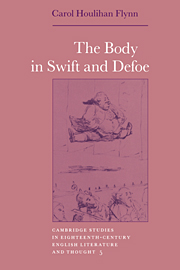Book contents
- Frontmatter
- Contents
- Acknowledgments
- List of abbreviations
- Introduction “The Dearness of things”: the body as matter for text
- 1 Dull organs: the matter of the body in the plague year
- 2 The burthen in the belly
- 3 Consuming desires: Defoe's sexual systems
- 4 Flesh and blood: Swift's sexual strategies
- 5 The ladies: d—ned, insolent, proud, unmannerly sluts
- 6 Chains of consumption: the bodies of the poor
- 7 Consumptive fictions: cannibalism in Defoe and Swift
- 8 Vital parts: Swift's necessary metaphors
- Afterword Suppose me dead; and then suppose
- Index
5 - The ladies: d—ned, insolent, proud, unmannerly sluts
Published online by Cambridge University Press: 21 September 2009
- Frontmatter
- Contents
- Acknowledgments
- List of abbreviations
- Introduction “The Dearness of things”: the body as matter for text
- 1 Dull organs: the matter of the body in the plague year
- 2 The burthen in the belly
- 3 Consuming desires: Defoe's sexual systems
- 4 Flesh and blood: Swift's sexual strategies
- 5 The ladies: d—ned, insolent, proud, unmannerly sluts
- 6 Chains of consumption: the bodies of the poor
- 7 Consumptive fictions: cannibalism in Defoe and Swift
- 8 Vital parts: Swift's necessary metaphors
- Afterword Suppose me dead; and then suppose
- Index
Summary
For, what was ever understood
By Human Kind, but Flesh and Blood?
“A Receipt to Restore Stella's Youth,” (Poems, II, pp. 758–60, lines 35–6)It could have been his dripping nose, “the first time I ever got a new cold before the old one was going,” or it could have been the more pressing uncertainties of the Tory ministry, but in spite of Christmas, Swift sounds less than charitable in his estimation of post-partum joys:
I was to see lady —, who is just up after lying-in; and the ugliest sight I have seen, pale, dead, old and yellow for want of her paint. She has turned my stomach. But she will soon be painted, and a beauty again.
(JS, p. 443)Lady — might possibly be Lady Pembroke, around forty-three years of age, but her situation more than her identity is the issue, for her bare corporeality offends. Paint, Swift suggests, can cover over her flaws, turning her into a “beauty” once again, but beauty so restored reveals itself to be rotten, the (dead) body beneath the varnish always retaining a certain stench.
Notable here is the neutrality, the flatness of the description. Swift is perfectly capable of lashing feminine offenders for any number of vices he longs to root out.
- Type
- Chapter
- Information
- The Body in Swift and Defoe , pp. 110 - 131Publisher: Cambridge University PressPrint publication year: 1990

